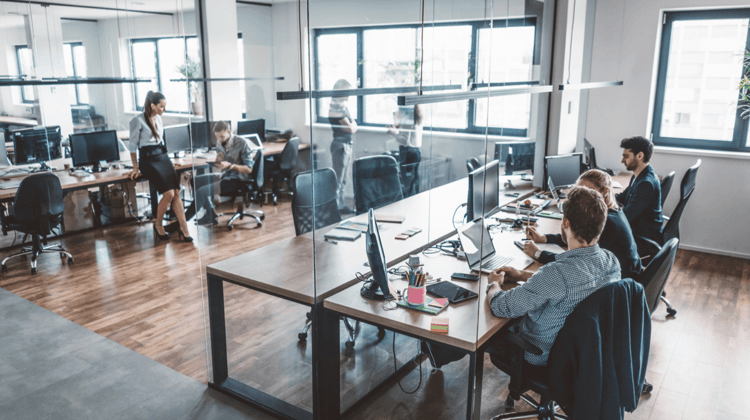Imagine you are an artist ready to paint your masterpiece, but when you reach for your tools, they lie scattered and chaotic. The time wasted searching would instead be spent creating, right? Similarly, inefficient facility planning can severely hamper an organization's operational efficiency, while streamlined facilities significantly boost productivity.
Strategic facility planning has emerged as a critical element in fostering smooth and cost-effective operations, from optimizing workflows to enhancing productivity. This article delves into the significance of meticulous facility planning and its profound impact on overall business efficiency.
What is Facility Planning?
Facility planning encompasses the systematic and comprehensive process of designing, organizing, and configuring physical spaces to support various functions within an organization effectively. It involves the strategic allocation of resources and space to ensure the smooth execution of operations, considering factors such as workflow optimization, equipment placement, safety regulations, and future scalability.
Successful facility planning entails a deep understanding of the specific requirements and objectives of the organization, aiming to create an environment that fosters operational efficiency, productivity, and a conducive work atmosphere.
What Does a Facility Planner Do?
A facility planner is the architect of a functional and efficient work environment. They're responsible for strategically designing and utilizing a company's physical assets, ensuring that they align seamlessly with the organization's goals and operational needs.
Think of them as the orchestra conductor, harmonizing various elements to create a symphony of productivity. They determine the optimal layout of workspaces, plan for future expansions or modifications, and even factor in sustainability aspects. Their role is a delicate balancing act, constantly adapting to evolving business requirements while keeping employee comfort and workflow efficiency in mind.
What Skills Do Facility Planners Need?
The success of facility planning hinges on a unique blend of technical expertise and interpersonal skills. A proficient facility planner should possess the following:
- Analytical Skills: Analyzing data to understand current space utilization, identify bottlenecks, and forecast future needs is crucial.
- Technical Proficiency includes understanding architectural plans, building codes, and safety regulations to ensure a compliant and secure workspace.
- Communication Skills: Effective communication is essential for collaborating with stakeholders, conveying plans, and managing expectations throughout the planning process.
- Problem-Solving Abilities: Unexpected challenges are inevitable in facility planning. A skilled planner can anticipate potential issues and devise practical solutions to keep projects on track.
- Attention to Detail: Every detail matters, from space allocation to furniture selection. A keen eye for detail ensures a well-coordinated and functional work environment.
This multifaceted skill set underscores the importance of facility planning in optimizing workspace dynamics and driving organizational success.
Importance of Facility Planning in Various Industries
Facility planning plays a critical role across different industries. Whether it’s manufacturing units striving for optimal machinery layout to increase production efficiency, hospitals aiming for patient-friendly navigation systems or educational institutions focusing on student-centric room arrangements - tailored facility designs greatly enhance performance metrics.
Essentially put; proper facilities planning serves as the backbone for efficient operations in sectors ranging from healthcare and education to manufacturing and software development.
Benefits of Effective Facility Planning
To clarify why investing time in this process is worthwhile, consider these potential advantages arising from effective facility planning:
- Improved Productivity: Efficient workspace layouts help streamline operations by reducing unnecessary movements or time waste.
- Enhanced Safety: Thorough evaluation during planning minimizes potential safety hazards.
- Cost Control: Strategic allocations reduce needless expenses such as energy wastage or space underutilization.
- Employee Well-being: A well-planned environment contributes positively towards employee morale and overall satisfaction.
Understanding that effective facility planning has measurable benefits could influence its inclusion into more businesses' strategic objectives, guiding them towards attaining operational efficiency effortlessly.
Key Elements of Facility Planning
At the heart of effective facility planning lie several key elements that play a deterministic role in an organization's successful operations. Let's delve into these integral components.
Identifying Facility Requirements Based on Organizational Needs
The first and arguably the most pivotal element in facility planning is understanding what your organization needs from its facilities. Is it large production rooms for manufacturing units? Or perhaps open office spaces that foster creativity for startups?
Identifying these requirements can include aspects like:
- Operational needs linked to machinery, staff, and processes
- Hygiene and comfort requirements pertinent to employee well-being
- Legal obligations such as disabled access or safety systems
Having clarity about this not only aids in designing efficient workspaces but also sets you on a more straightforward path toward meeting strategic goals with adept operational facilities management.
Assessing Existing Facilities and Infrastructure
Once the requirements are clear, the next important step involves critically evaluating existing structures: their efficiencies, deficiencies, potential for improvement, or need for complete overhauling.
Look at parameters like space utilization (are all areas being optimally used?), energy efficiency measures currently employed (an opportunity to cut expenses), and any recurrent complaints about specific areas (possible bottlenecks), among others. You can anticipate challenges better by juxtaposing the actual state with desired outcomes.
Designing Optimal Layout Space Allocation
This step centers around mapping out every inch of your available space carefully considering the flow of workers/equipment/materials—a part-and-parcel of the facilities planning process.
Herein lies the challenge—and beauty—of merging aesthetic appeal and functional efficacy. Where should your server rooms be? How can the cafeteria be placed to limit noise intrusion into work zones?
The facility operations management plans must consider aspects of privacy while still encouraging collaboration, security considerations, maximizing employee comfort levels, etc. The effective use of space fosters better productivity, thereby contributing to overall operational efficiency.
What Are the Principles of a Good Facility Layout?
A good facility layout considers several principles to optimize the workplace. These principles help create an efficient, safe, and productive environment for employees. The facility layout should support the company's overall business objectives and be flexible enough to adapt to future changes.
There are many different facility layouts, each with advantages and disadvantages. The best layout for a particular facility will depend on its specific needs and requirements. Some fundamental principles to consider when designing a facility layout include the following.
- The flow of materials and people. The layout should allow for the efficient movement of materials and people throughout the facility.
- Accessibility. The layout should provide easy access to all facility areas, including workstations, equipment, and storage.
- Safety. The layout should be designed to minimize the risk of accidents and injuries.
- Flexibility. The layout should be flexible enough to accommodate future changes in the facility's needs.
- Aesthetics. The layout should be aesthetically pleasing and create a positive work environment.
By considering these principles, businesses can create a strategic facilities plan that meets their needs and optimizes workplace efficiency. Moreover, organizations can leverage facilities planning solutions to ensure their workspace is well-designed and effectively managed. As a result, the facility will support its workforce, enhance productivity, and contribute to achieving its overall business goals.
Considering Safety and Security Measures in Facility Planning
Hygiene standards, fire-safety compliance, or more robust cybersecurity measures cannot be relegated to an afterthought in facility planning.
Employee safety—one of the fundamental pillars for success—ensures smoothly running, uninterrupted operations that can significantly impact an organization's bottom line. A judicious mix of technology (from access control systems to CCTV cameras) and a vigilant workforce can enhance these measures.
Incorporating Sustainability and Green Practices in Facility Design
Reducing organizational carbon footprint isn't simply trendy—it's a sustainable practice integrated with high-yielding returns potential. Green buildings boost occupant health, undoubtedly affecting productivity positively. This also helps cut operating costs via efficient resource utilization like water conservation or power optimization strategies.
Innovations around recycling waste office products or even introducing rooftop gardens manifest as thoughtful gestures towards building eco-friendly environments.
Taking strides towards incorporating sustainable tools and practices at this stage pays not just rich environmental dividends but market benefits too by positioning you as a responsible corporate citizen who cares about its impact on our planet.

The Facility Planning Process
Let's familiarize ourselves with the facility planning process— from data gathering and assessment to applying the final touches to our facility.
Gathering Data and Conducting Needs Assessment
This step is all about knowing what your organization needs. Think about how many people work there, what they do, and what they need to do it well. This information will be like a plan for the next steps in facility planning.
Also, it's important to figure out what you're missing. Look for places where your current facilities aren't meeting your needs or the standard for your industry. This will help you make a good plan for managing your facilities.
Establishing Goals and Objectives for the Facility Plan
After meticulously analyzing all possible scenarios through data accumulation and need assessments, you should pinpoint specific objectives for your design. Is boosting operational efficiency atop your list? Or maybe constructing an agile workspace catering to advanced technology trends is your priority? Remember that every company is unique; facility planning goals must align intricately with its ethos and strategies.
Developing a Comprehensive Facility Plan Document
A good document lays out all the important details about what you want to achieve and when. It's not just about figuring out where things should go but also thinking about how to keep everyone safe, making room for growth, using eco-friendly practices, and staying within your budget. A facility plan document should cover all aspects of managing your facilities in the best way possible.
Obtaining Stakeholder Input and Securing Necessary Approvals
To reach successful outcomes from facility planning procedures, it's advisable to involve key stakeholders in decision-making processes early on. Their valuable insights can refine drafts by plugging unforeseen gaps. Seeking necessary approval ensures that there won't be any interruptions midway during implementation due to non-compliance issues.
Implementing the Facility Plan, Including Construction or Renovations
After securing solid approvals, the next step is bringing your vision alive. Contracting reputable vendors while ensuring all design facets align with predefined strategies is crucial during this phase. Note that any construction or large-scale renovation task necessitates adequate resource allocation and efficient project management.
Keeping up with the Future of Work Trends
In today's rapidly changing world, facility planning is not static. Staying ahead of the curve is crucial to monitoring future work trends and anticipating how they might impact your workplace needs.
The rise of remote work, flexible schedules, and collaborative technologies is reshaping traditional office environments. Consider how these trends influence your space requirements, technology infrastructure, and overall workplace design to create a sustainable facility plan. By staying informed about the future of work, you can design adaptable and future-proof facilities that can accommodate evolving work styles and technologies.
Setting Facility Management KPIs
Establishing key performance indicators (KPIs) is crucial for measuring the effectiveness of your facility planning efforts. These metrics will help you track your progress toward achieving your goals and identify areas that require further attention.
Consider KPIs such as space utilization, employee satisfaction, energy efficiency, and operational costs. By regularly monitoring these metrics, you can gain valuable insights into your facilities' performance and make necessary adjustments to optimize their effectiveness.
Monitoring and Evaluating the Effectiveness of the Facility Plan
A really important but sometimes forgotten aspect of facility planning is checking how things are going after you've made changes. See if your plans work like you hoped by comparing what you expected to what's happening.
Gathering information about how the space is used, how much energy is used, and how happy employees are can help you understand what's going well and what's not. Regular check-ins can help you find and fix problems in how your facilities are running and keep making things better.
Technology and Innovation in Workplace Facility Planning
Technology and innovation have revolutionized workplace facility planning in today's corporate landscape. Understanding the synergy between technology and workspace planning is crucial in creating functional, future-proof environments.
Utilizing Software for Space Planning & Visualization
In contemporary facility planning, advanced workspace software is essential for managing and optimizing workspace resources.
One of the pivotal aspects of workspace software solutions is the integration of interactive floor maps, which serve as a vital interface for visualizing, strategizing, and executing effective space planning initiatives. These dynamic maps provide a comprehensive and user-friendly representation of the spatial layout, allowing facility managers and employees to understand the available space and its potential uses.
By leveraging interactive floor maps, businesses can seamlessly navigate through intricate floor plans, comprehensively assess spatial dynamics, and make informed decisions regarding the allocation of resources. Such visual office representation empower facility managers to efficiently track occupancy, identify underutilized areas, and strategically plan for future scalability and growth.
Yarooms, for example, offers a sophisticated workplace booking platform incorporating interactive floor maps, enabling businesses to streamline their facility planning processes with precision and agility.
Applying Iot (Internet of Things) Technology for Facility Management and Monitoring
Adding Internet of Things (IoT) technology to today's facilities presents new opportunities. IoT devices can accurately monitor energy usage, maintain temperatures at optimal levels, manage lighting systems, or even oversee security aspects - all in real time.
These smart devices facilitate proactive maintenance practices, eliminating the need for guesswork associated with traditional methods. Leveraging IoT technology prevents unexpected breakdowns by detecting anomalies early on, hence potential savings on repair costs. Moreover, valuable insights from compiled IoT data aid in making informed decisions about operational performance improvement.
Incorporating Sustainable Building Practices and Energy-Efficient Systems
With increasing awareness about the environmental impacts of buildings’ carbon footprint, sustainable building practices are gradually becoming mainstream.
Green buildings are designed and operated to use resources more efficiently than their conventional counterparts. Energy-efficient systems such as solar panels or low-energy lighting significantly reduce utility bills while reducing detrimental ecological effects.
Further adoption of environmentally focused strategies like roof-top gardens adds aesthetic value and provides insulation, reducing the need for artificial heating or cooling. Equally noteworthy is the utilization of recyclable materials during construction stages, contributing to a sustainable and eco-friendly facility plan.
Exploring Emerging Trends in Facility Planning
Emerging trends in workplace facility planning reflect a paradigm shift in the modern workforce dynamics, driven by evolving technological landscapes and changing employee expectations.
One of the predominant trends is the integration of flexible and adaptable spaces that accommodate hybrid work models, catering to the needs of both remote and in-office employees. This has led to the rise of activity-based workplaces, fostering collaboration and creativity by incorporating diverse work settings such as collaborative zones, quiet spaces, and wellness areas.
Additionally, the emphasis on sustainability has become a critical focal point, with companies increasingly incorporating eco-friendly designs, renewable energy sources, and biophilic elements to create healthier and more environmentally conscious work environments.
Furthermore, integrating technologies and data-driven solutions has gained traction, enabling efficient space utilization, improved employee well-being, and optimized resource management.
As workplace dynamics continue to evolve, integrating these trends remains crucial in creating dynamic, efficient, and future-ready workplaces that foster productivity, innovation, and employee satisfaction.
Challenges in Workplace Facility Planning
Facility planning poses multifaceted challenges. Overcoming these hurdles is vital for efficient resource use and fostering productive, employee-friendly work environments.
Budget Constraints and Cost Management in Facility Planning Projects
Managing a budget can often feel like navigating through a tricky labyrinth. When it comes to facility planning, budget constraints can pose significant challenges. From securing appropriate funding sources to controlling operational facilities' expenditures, cost management is integral to the facility planning process.
Accurately estimating project costs is a vital task that helps avoid down-the-road money pitfalls. A surprise invoice or an unplanned repair could blow up your entire budget. Therefore, you must thoroughly consider all potential expenses at the onset of operating facilities.
Effective cost control strategies in facility plans don't always follow straight lines or beeline towards cutting corners; they require complex decision-making processes and ongoing adjustments.
Adapting to Changing Technology Trends and Advancements
In today's digital age, keeping up with technology is crucial for managing facilities efficiently. However, using new technologies comes with its challenges.
Implementing systems like IoT or computer-aided design tools involves integrating them with existing structures, which can take time and effort. It's important to anticipate potential issues and provide training for staff involved in facility management.
Moreover, as technology advances quickly, installed systems can become outdated before their expected lifespan, leading to financial implications for organizations. Overall, incorporating modern technology into facility planning requires well-thought-out strategies not only for initial implementation but also for ongoing maintenance and upgrades.
Addressing Potential Risks and Mitigating Them during the Planning Process
Risk assessment is crucial for facility planning. It means identifying possible issues in operations, like structural problems or not meeting regulations. A good plan should prioritize dealing with these early on. Also, flexibility is essential because things might sometimes go differently than planned. Managing risks is critical for successful and sustainable facility planning, starting with everyday operations.
Balancing the Need for Flexibility with Long-Term Facility Planning Goals
Finding the right balance between flexibility and long-term goals is a big challenge in facility planning. You want plans that can handle future changes but aren't so inflexible that they need redoing with every slight shift. For example, in designing a workplace today, you might use popular ideas like agile workspaces and remote work. But it's wise also to plan for these trends to change, ensuring your plan can adapt and maintain your primary goals. In essence, it's about being flexible while staying focused on your long-term vision.

Future Outlook and Trends in Facility Planning
Facility planning continues evolving. Advances in technology, shifting workplace trends, and an increased emphasis on sustainability will significantly influence how facilities are planned.
Anticipated Advancements and Technologies in Facility Planning
Companies across various sectors leverage technological advancements to boost operational efficiency through effective facility planning.
- Artificial Intelligence (AI) - AI can aid in predictive maintenance, allowing for repairs or upgrades before resources break down entirely.
- Internet of Things (IoT) - IoT devices offer real-time monitoring and data collection, promising improved energy efficiency and overall performance.
- Augmented Reality (AR) - AR provides architects with a powerful visualization tool to design architecturally interesting spaces that meet functional needs.
Given this trajectory, it's reasonable to anticipate even more dynamic tools coming into play in the near future.
Evolution of Workplace Design and Its Impact on Facility Planning
Shifts in workplace design trends significantly affect facility planning strategy. The move towards open office layouts peaked around the mid-2010s but has seen some pushback recently due to noise and privacy concerns. Instead, many organizations find value in incorporating activity-based working environments that result in uniform usage of space throughout the workday.
Remote work capabilities will likely continue impacting office designs as businesses adapt post-pandemic norms into their long-term facility plans.
Sustainable Practices and Their Influence on Future Facility Plans
Sustainability is more than a trend—it's becoming central to strategic facility planing worldwide. This shift promotes environmentally conscious practices like:
- Building materials with low environmental impact
- Systems for rainwater harvesting
- Energy-efficient heating and cooling systems
- Green roofs that improve insulation while reducing water runoff
- Employing circular economy principles where waste becomes an input rather than an output
These green practices can reduce energy usage, lower maintenance costs, and elevate a company's reputation—a win-win for facility planning & control with a forward-thinking focus.
Final Thoughts on the Importance of Facility Planning for Organizational Success
Effective facility planning and management encompasses far more than space allocation—it's about foreseeing change and designing today's buildings to meet tomorrow's demands.
A well-executed facility plan boosts operational efficiency, enhances employee satisfaction, reduces costs, and can even support an organization's environmental agenda. Without question, strategic facility planning will continue to play a pivotal role in achieving organizational objectives.












